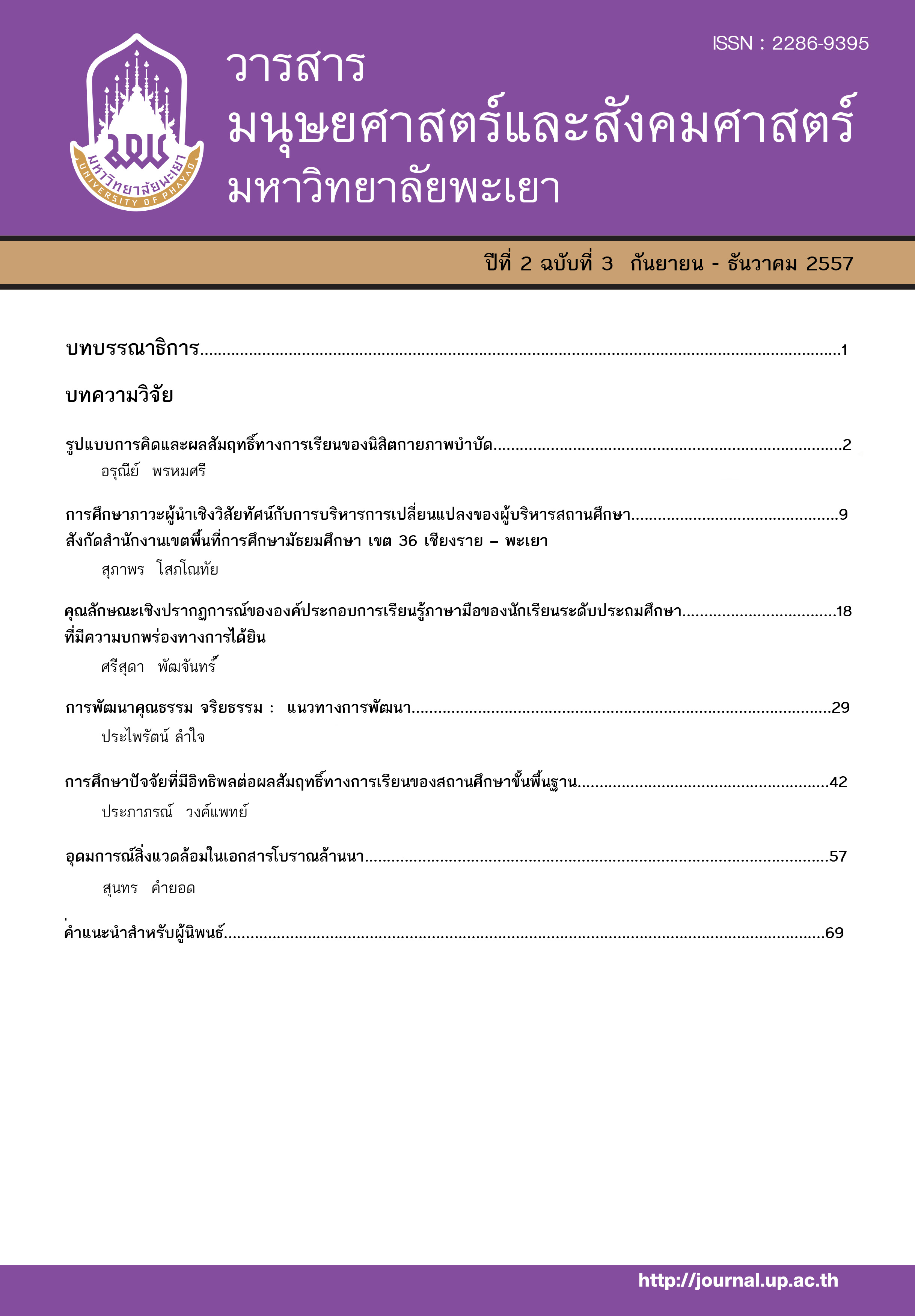The Phenomenal Characteristics of Factors on the Sign Language Learning of Elementary Hearing Impaired Students
Keywords:
Sign Language Learning, Hearing Impaired Students, Phenomenal CharacterristicsAbstract
The purpose of this study was 1) to analyze confirmatory factors on the sign language learning of elementary hearing impaired students and 2) to investigate the phenomenal characteristics of factors on the sign language of elementary hearing impaired students by applying Mixed Method Research; quantitative and qualitative approach. The participants consisted of students, parents and instructors of hearing impaired students in elementary school during the second semester in the academic year of 2013. There were 207 students in Deaf School by the authorized of Bureau of Special Education, 207 parents and 33 instructors. The research instrument included a questionnaire with 3 scale. The statistical procedure employed to analyze the data was confirmatory factor analysis. Data collection in part of qualitative approach received from individual interview and content analysis was used.
The finding were as follow: Factors on the sign language learning of hearing impaired students conformed to the empirical data. There were 4 latent variables which were family, education, students and society and 13 observable variables. The statistical result are= 52.20, = 36, = .03951, /=1.45, GFI = .96, AGFI = .91, RMSEA = .047. Phenomenon characteristic of family: parents offered their children a special care and considered on the importance of sign language in the school with high level of student’s proficiency. On the other hand, in the school with low level of students’ proficiency, parents lacked of the knowledge about hearing impaired children and sign language. They are also pessimistic. Education: in the school with high level of student’s proficiency, teachers were masterful in terms of instruction for hearing impaired students. In addition, students were provided the appropriate environment and full facilities. In contrast with the school of students’ low proficiency, teachers were inadequate of sign language teaching skill. The development of sign language teaching among those teachers was inadequate. Student: in the school with high level of student’s proficiency, most students owned high availability and responsibility in their education. On the contrary, in the school with low level of student’s proficiency, it was found that students were redundancy disabled children. They also suffered from family issue along with their belated education. Society: students could effectively improve their sign language skill with their friends. Most students lived with their friends happily and received the assistance among group in terms of sign language communication. Thus, friend was considered as one of the most important parts for hearing impaired students.
References
จิตประภา ศรีอ่อน. (2550). บทสรุปสำหรับผู้บริหารรายงานการวิจัยเรื่องความสามารถด้านการอ่าน และการเขียนภาษาไทยของนักเรียนที่มีความบกพร่องทางการได้ยินชั้นมัธยมศึกษาปีที่ 6 โรงเรียนโสตศึกษา. วิทยาลัยราชสุดา มหาวิทยาลัยมหิดล.
มาลี อรุณากูร. (2554). การสื่อสารกับเด็กที่มีความบกพร่องทางการได้ยินในงานทันตกรรมสำหรับเด็กที่มีความบกพร่องทางการได้ยิน. กรุงเทพฯ : พี.เอ.ลีฟวิ่ง จำกัด.
วรัชญา ชาลี. (2555). โลกของคนหูหนวก. วิทยานิพนธ์ปริญญาสังคมวิทยา และมานุษยวิทยามหาบัณฑิต สาขาวิชามานุษยวิทยา คณะสังคมวิทยาและมานุษยวิทยา มหาวิทยาลัยธรรมศาสตร์.
วีระศักดิ์ จันทร์ส่องแสง. (2549). เสียงจากโลกเงียบ มือสื่อภาษา ตาสื่อใจ. กรุงเทพฯ: สามลดาการพิมพ์.
สมพร หวานเสร็จ. (2552). การประเมินโครงการโรงเรียนต้นแบบการทดลองสอนแบบสองภาษาสำหรับนักเรียนหูหนวก. วิทยาลัยราชสุดา มหาวิทยาลัยมหิดล.
สมาคมคนหูหนวกแห่งประเทศไทย. (2533). ปทานุกรมภาษามือไทยฉบับปรับปรุงและขยายเพิ่มเติม.
สำนักงานคณะกรรมการการศึกษาขั้นพื้นฐาน. แผนพัฒนาการจัดการศึกษาสำหรับคนพิการระยะ 5 (พ.ศ.2555-2559) ของกระทรวงศึกษาธิการ.
อรัญญา บุญมาเลิศ. (2548). ปัญหาการสื่อสารการสอนนักเรียนที่มีความบกพร่องทางการได้ยินในโรงเรียนเศรษฐเสถียร. วิทยานิพนธ์วารสารศาสตรมหาบัณฑิต สาขาการสื่อสารภาครัฐและเอกชน คณะวารสารศาสตร์และสื่อสารมวลชน มหาวิทยาลัยธรรมศาสตร์.
อัญชลี ด่านวิรุฬหวณิช. (2539). ความคาดหวังของผู้ปกครองต่อการมีส่วนร่วมในกิจกรรมทางสังคมของเด็กหูหนวก: ศึกษาเฉพาะกรณีโรงเรียนสอนคนหูหนวกในเขตกรุงเทพมหานคร. วิทยานิพนธ์ปริญญาสังคมสงเคราะห์ศาสตรมหาบัณฑิต คณะสังคมสงเคราะห์ศาสตร์ มหาวิทยาลัยธรรมศาสตร์.
อารีลักษณ์ คีมทอง. (2544). กรณีศึกษาเกี่ยวกับการเลี้ยงดูบุตรของครอบครัวที่มีต่อลูกหูหนวก. วิทยานิพนธ์ปริญญาศิลปศาสตรมหาบัณฑิต สาขาวิชางานบริการฟื้นฟูสมรรถภาพคนพิการ บัณฑิตวิทยาลัยมหาวิทยาลัยมหิดล.
Chandee. (2011). Learning Framework for Hearing Impaired Students. Doctor dissertation, Faculty of Industrial Education and Technology King Mongkut’s University of Technology Thonburi.
Meadow, S.G., & Mayberry, R.I. (2001). How do profoundly deaf children learn to read?. Learning Disabilities Research & Practice, 16(4), 222-229.
Meronen, A., & Timo, A.(2008). Individual differences in Sign Language abilities in deaf children. American Annals of the deaf, 152 (5), 495-504.
Pizer, G.B. (2008). Sign and speech in family interaction: Language choices of deaf parents and their hearing children. Doctoral dissertation, Faculty of the Graduate School, University of Texas at Austin.
Pizzo , L. (2013). Vocabulary instruction for the development of American sign language in deaf children: An investigation into teacher knowledge and practice. Doctoral dissertation, Department of Teacher Education, Special Education, and Curriculum and Instruction Curriculum and Instruction, Boston College.
Downloads
Published
How to Cite
Issue
Section
License
ผู้นิพนธ์ต้องรับผิดชอบข้อความในบทนิพนธ์ของตน มหาวิทยาลัยพะเยาไม่จำเป็นต้องเห็นด้วยกับบทความที่ตีพิมพ์เสมอไป ผู้สนใจสามารถคัดลอก และนำไปใช้ได้ แต่จะต้องขออนุมัติเจ้าของ และได้รับการอนุมัติเป็นลายลักษณ์อักษรก่อน พร้อมกับมีการอ้างอิงและกล่าวคำขอบคุณให้ถูกต้องด้วย
The authors are themselves responsible for their contents. Signed articles may not always reflect the opinion of University of Phayao. The articles can be reproduced and reprinted, provided that permission is given by the authors and acknowledgement must be given.








